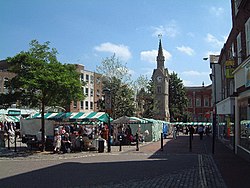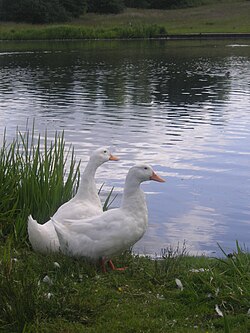Aylesbury
| Aylesbury | |
| Buckinghamshire | |
|---|---|
 Market Square, Aylesbury | |
| Location | |
| Grid reference: | SP818138 |
| Location: | 51°49’0"N, -0°48’45"W |
| Data | |
| Population: | 56,392 (2001) |
| Post town: | Aylesbury |
| Postcode: | HP19, HP20, HP21 |
| Dialling code: | 01296 |
| Local Government | |
| Council: | Buckinghamshire |
| Parliamentary constituency: |
Aylesbury |
Aylesbury is the county town of Buckinghamshire. It stands on an outcrop of Portland limestone, giving it a prominent position in the surrounding marled landscape.
Once a quiet market town, Aylesbury's population has doubled since the 1960s as new housing developments have been built to accommodate London overspill. Much of the town's historic town centre was demolished in the 1950s and 1960s to make way for commercial developments. Nevertheless, the core and several interesting Victorian buildings remain. The town serves as a centre in its own right and as a commuter town, linked by the Chiltern Main Line to London's Marylebone Station.
The town centre has many pubs and bars, along with some nightclubs, and Friday and Saturday nights can be lively.
Buildings


Many little streets in Aylesbury bear the jaunty architecture typifying the market towns of southern England. County Hall was built in the seventeenth century to a design by local architects approved by no less than John Vanbrugh. It stands in the middle of town, still serving the administration of justice as home to the Aylesbury Crown Court.
If the Market Square has lost most of its historic buildings, it retains their memory in its paved footpaths and stone setts. The Clock Tower in the centre was built in 1877. Another thing lost to the Market Square at end of the 20th century was a twice-weekly sheep, pig and cattle market.
Most of the older buildings in the town are found in the streets surrounding Market Square, many noble Georgian edifices, with some smaller Tudor and Jacobean houses. In the Old Town are, amongst others, the Kings Head Coaching Inn, the County Museum (with a Roald Dahl Children’s Gallery), and the Prebendal House of 18th century, once home to the famous and infamous member of Parliament, John Wilkes; he of the old cry Wilkes and Liberty!
The Crown Courts stand at the bottom of the Market Square. In the days of the noose, the convicted were not only judged there but were hanged publicly from a balcony before the Court House. The Green Man Inn (now The Square) did a good trade accommodating paying spectators.
Ceely House (part of the County Museum), Ardenham House, the Union Workhouse and the County Gaol are among the most notable buildings in the town.
St Mary's Church, sited upon a hill surrounded by narrow streets and squares of substantial 18th century town houses, such as Castle Street, Temple Square and Parson's Fee give an indication of how Aylesbury may have appeared in the 18th century.
History
The name of Aylesbury is of Old English origin. It was a major market town in Anglo-Saxon times, and a pilgrimage place for its shrine of Saint Osyth. At the Norman Conquest, the King took the manor of Aylesbury for himself, and it is listed as a royal manor in the Domesday Book of 1086.

The crypt of St Mary's, the parish church, was once once thought to be Anglo-Saxon, but is now considered mediaeval, of a piece with the fabric above.
In 1450 a religious institution called the Guild of St Mary was founded in Aylesbury by John Kemp, Archbishop of York. Known popularly as the Guild of Our Lady it became a meeting place for local dignitaries and a hotbed of political intrigue, influential, it is said, in the final outcome of the Wars of the Roses. It was dissolved at the Reformation, its premises at the Chantry in Church Street, Aylesbury, remain, though the site is occupied mainly by almshouses.
Henry VIII declared Aylesbury the county town of Buckinghamshire in 1529 in place of Buckingham. As Aylesbury Manor belonged to Thomas Boleyn, the father of Anne Boleyn it was rumoured that the change was made in order to curry favour with Thomas. Nevertheless, Aylesbury's prosperity and position in the centre of the county suited its position admirably.

In the English Civil War, Aylesbury became a Parliamentarian stronghold. In 1642 the Battle of Aylesbury was fought and won by the Parliamentarians. Its proximity to Great Hampden, home of John Hampden has made of Hampden a local hero: his silhouette is on the emblem used by Aylesbury Vale District Council and his statue stands prominently in the town centre. Aylesbury born composer, Rutland Boughton (1878–1960), possibly inspired by the statue of John Hampden, created a symphony based on Oliver Cromwell.
Hartwell, a nearby Jacobean mansion, was the residence of Louis XVIII of France during his exile, from 1810–1814, his court there a centre of intrigue frequented by those who would benefit from his favour at Napoleon's fall. Bourbon Street in Aylesbury is named after the king. Louis's wife, Marie Josephine of Savoy died at Hartwell in 1810 and is buried in the churchyard there, the only French Queen to be buried on English soil.
Chequers, the country residence of the Prime Minister since 1921, lies just southeast of Aylesbury.
Aylesbury Duck

The Aylesbury Duck is a local fowl, and a local speciality both on the pond and on the plate. Aylesbury Vale has many brooks and ponds frequented by ducks, and the Aylesbury Duck, pure white of feather, with a flesh coloured beak, with bright orange legs and feet, is valued by chefs and bon-viveurs for the richness of its flavour.
The Aylesbury duck has been adopted as the heraldic emblem of the town of Aylesbury.
Gallery
-
Church Street
-
Cambridge Street
-
The King's Head
-
Blue Leanie office block



